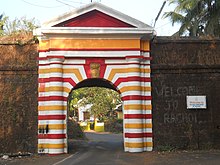An 18th Century Stone with a Story
- Alan Machado

- Aug 12, 2024
- 3 min read
Updated: Mar 23

An engraved granite stone presently placed at the entrance of Rosario Cathedral records the one-time presence of a Portuguese factory at that particular, or a nearby, site. The stone bears the court of arms of a king of Portugal[1], most probably Dom Joao V (1706-1750).[2] Unfortunately, the letters are defaced and present problems in deciphering. The court of arms, however, is clearer and helps date the stone with some degree of accuracy. But before we do that, let us review some background information.
Between 1652 and 1654, the Ikeri ruler Shivappa Nayaka captured the Portuguese forts located at Mangalore (1653), Kundapur, Gangolly, and Honavar. Twenty years later, however, Somashekara Nayaka I, finding himself under attack from Bijapur, sought Goa’s military assistance. Goa used this to extract concessions which the treaty of 1671 lists out. Among them was the establishment of factories with low walls in Mangalore, Kundapur, and Honavar. This clause was repeated in the next treaty with Rani Chennammaji in 1678. It implies that these factories had not yet been built. This treaty, however, introduces a number of new clauses in favour of the Portuguese, one of them allowing them to build a church within the factory wall. These clauses were repeated again in a 1707 treaty, clearly placing the construction of the first Rosario church at the present site of the Cathedral after this date. This church was rebuilt more than once.
The Rosario stone probably stood at the entrance of the factory when it was built and confirms it came up only during the reign of Joao V, not before. Two numerals are decipherable, 7 and 2, which links the stone to some event in the 1720s. It is known that the factory and church existed by 1718 as Alexander Hamilton, who visited Mangalore that year, mentions both.
This site was not a strong defensible fort, but a warehouse defended by a small garrison and four cannon. It was supposed to guard the bundar which was periodically raided by Maratha pirates, and for this service was allowed to collect a duty on the goods that were imported and exported from the harbour. The factory was captured in 1768 by an English force commanded by Gouin, and the factor packed off to Goa. Haider retook the factory within weeks, and in return for military supplies and expertise from Goa, allowed the Portuguese to resume operations at the factory. Portuguese aid did not come up to Haider's expectations. He took back the site in 1771 for the construction of his own fort under the direction of a Frenchmen, Catini. Rosario Church remained outside this fort and was pulled down on Tipu’s orders in 1784.

The Rosario stone has an engraved court of arms of the king of Portugal above the inscription. This particular design was adopted by more than one king with slight variations. However, this particular engraving, and other details listed here, reveals it belonged to D. João V (1706-1750). The shape of the shield or escutcheon is in the "Modern French" style (a square with rounded edges and a point at the bottom), which does not appear in earlier reigns. Earlier forms were either rounded, rounded with a point at the bottom. The crown above the shield also helps date the stone. Before the 1680s, the crown had only three stems. Two more were added during the reign of Pedro II (1668/83-1706), Joao V's predecessor, although his reign maintained the rounded shape of the shield in the Spanish or Flemish style. The date on inscription, though defaced and not definitive, places the installation of the stone to the 1720s.
It is interesting to compare the slight variations in this court of arms with that built over the entrance gate to Rachol fort in Goa which was renovated in 1745 during the reign of D. Joao V, as well as the painting of the king’s court of arms in the Thesouro da Nobreza de Portugal, 1783. Each of them were done in widely separated places, and on different media (granite, plaster, paper), none of which allowed easy or inexpensive corrections in that age.
[1] Manuel de Santo Antonio e Silva. 1783. Tesouro da Nobreza de Portugal. PT-TT-CR-D –A-1-16_m0013.TIF. https://digitarq.arquivos.pt/viewer?id=4162404
References
Inputs from :
John Monteiro (Universidade Estadual de Campinas, Brazil)






Comments